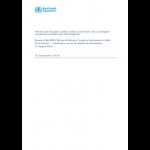
In March 2015, the World Health Organization (WHO) convened its Technical Working Group on Innovations in Male Circumcision (TAG) to review reports from voluntary medical male circumcision (VMMC) programmes of six tetanus cases. After receiving reports of an additional six tetanus cases by May 2016, WHO held another technical consultation in June 2016 to review the evidence and update its 2015 recommendations for preventing this rare but serious complication following VMMC. The TAG reviewed additional information during a teleconference on 12 August 2016, and this final report of the consultation was published on 12 September 2016, with updated recommendations on tetanus prevention.
The TAG members unanimously endorsed the conclusion reached in June 2016 of a higher risk of tetanus following circumcision with the elastic collar compression device compared with other circumcision methods that remove the foreskin at the time of the procedure. They recommend that male circumcision with a device that is removed along with the foreskin several days after it is applied should be performed only if the client is adequately protected against tetanus by immunizations. (To date, WHO has prequalified one elastic collar compression device.) The TAG members made no new recommendations for preventing tetanus after conventional male circumcision surgery, but reiterated the need for clean care of circumcision wounds, better education of clients and caregivers about harmful wound-care practices, and ensuring that clients have documented evidence of a full five-dose series of tetanus-toxoid-containing vaccine (TTCV) or be administered at least one TTCV dose before or at the time of the procedure. More information about the findings and recommendations of the consultations can be found on the WHO website.